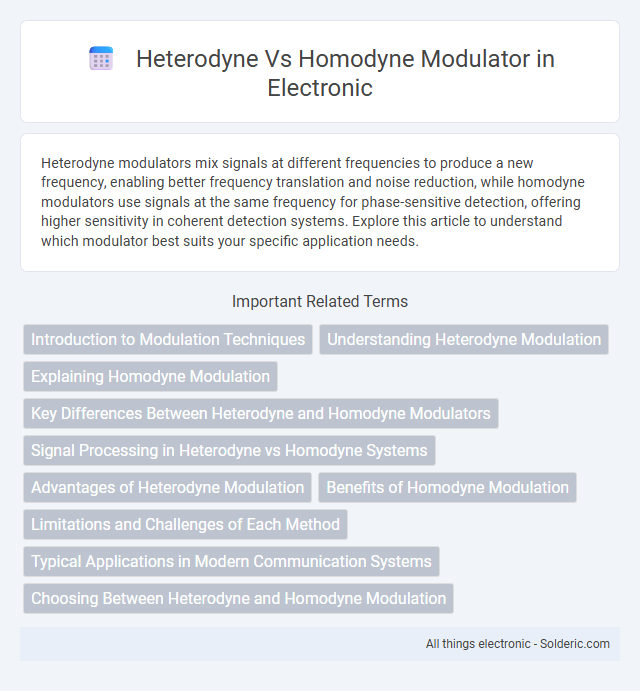Heterodyne modulators mix signals at different frequencies to produce a new frequency, enabling better frequency translation and noise reduction, while homodyne modulators use signals at the same frequency for phase-sensitive detection, offering higher sensitivity in coherent detection systems. Explore this article to understand which modulator best suits your specific application needs.
Comparison Table
| Feature | Heterodyne Modulator | Homodyne Modulator |
|---|---|---|
| Operating Principle | Mixes input signal with a different frequency local oscillator (LO) signal | Mixes input signal with local oscillator at the same frequency |
| Frequency Output | Generates sum and difference frequencies | Outputs baseband or zero intermediate frequency |
| Complexity | Higher due to frequency conversion stages | Lower, simpler architecture |
| Applications | RF communication, radar systems, frequency translation | Coherent detection, phase-sensitive measurements |
| Signal Processing | Requires filtering to separate frequencies | Direct extraction of amplitude and phase |
| Noise Performance | Typically higher due to frequency conversion | Improved signal-to-noise ratio (SNR) |
| Bandwidth | Wide bandwidth possible | Limited by LO stability and phase noise |
Introduction to Modulation Techniques
Heterodyne and homodyne modulators represent fundamental techniques in optical and radio frequency signal processing, where heterodyne modulation mixes two different frequencies to produce a beat frequency used for signal detection or frequency conversion. Homodyne modulation, in contrast, employs a reference signal at the same frequency as the carrier wave, enabling phase-sensitive detection that enhances signal-to-noise ratio and bandwidth efficiency. These modulation strategies are critical in applications such as coherent communication systems, LIDAR technology, and spectroscopy, where precise frequency control and signal integrity are paramount.
Understanding Heterodyne Modulation
Heterodyne modulation involves mixing two signals with different frequencies to produce new frequencies that are the sum and difference of the originals, enabling efficient frequency translation and improved signal processing. You benefit from heterodyne modulators in applications requiring high sensitivity and selectivity, such as radar and communication systems, where they convert high-frequency signals to intermediate frequencies for easier detection. Unlike homodyne modulators, which mix signals at the same frequency and produce a baseband output, heterodyne modulation offers enhanced noise performance and flexibility in signal analysis.
Explaining Homodyne Modulation
Homodyne modulation involves mixing a received signal with a local oscillator of the same frequency to directly extract the baseband signal, resulting in zero intermediate frequency. This method reduces phase noise and simplifies the receiver design, making it highly efficient for coherent detection in optical communication systems. Your system benefits from improved signal quality and reduced complexity compared to heterodyne modulation, which uses a frequency offset between the local oscillator and signal.
Key Differences Between Heterodyne and Homodyne Modulators
Heterodyne modulators mix two different frequencies to produce an intermediate frequency signal, enabling better noise reduction and frequency selectivity. Homodyne modulators use a single frequency reference for modulation and demodulation, offering simpler implementation with higher sensitivity but increased susceptibility to phase noise. The key differences lie in frequency handling, noise performance, and complexity, with heterodyne systems providing enhanced selectivity at the cost of increased hardware requirements.
Signal Processing in Heterodyne vs Homodyne Systems
Heterodyne modulators utilize two different frequency signals, enabling the translation of a signal to an intermediate frequency that simplifies filtering and amplification, enhancing signal-to-noise ratio and selectivity. Homodyne modulators mix the incoming signal with a local oscillator at the same frequency, producing baseband signals that allow direct demodulation but may suffer from DC offset and phase noise. Your choice between heterodyne and homodyne systems impacts complexity, sensitivity, and the quality of the signal processing chain in communication and radar applications.
Advantages of Heterodyne Modulation
Heterodyne modulation offers superior signal separation by mixing two frequencies, enabling easier frequency translation and improved selectivity compared to homodyne modulators. This technique enhances sensitivity in low-frequency signal detection and reduces noise interference, leveraging intermediate frequencies for better signal processing. The inherent frequency offset in heterodyne systems minimizes DC offset and flicker noise, resulting in higher measurement accuracy and stability.
Benefits of Homodyne Modulation
Homodyne modulation offers enhanced signal-to-noise ratio by mixing the received signal with a local oscillator at the same frequency, enabling precise phase and amplitude measurements ideal for coherent optical communication. It reduces phase noise and improves sensitivity compared to heterodyne modulation, which involves mixing signals of different frequencies. This leads to simpler receiver design and higher spectral efficiency in applications like fiber-optic networks and radar systems.
Limitations and Challenges of Each Method
Heterodyne modulators face limitations due to frequency offset noise and complexity in maintaining stable frequency mixing, which can degrade signal quality and increase system cost. Homodyne modulators struggle with DC offset and flicker noise, leading to challenges in accurate phase detection and reduced sensitivity in low-frequency applications. Both methods require precise control of optical and electrical components to minimize distortions and optimize performance in high-speed communication systems.
Typical Applications in Modern Communication Systems
Heterodyne modulators are commonly used in microwave and radio frequency communication systems for frequency translation and channel multiplexing, enabling efficient signal processing in radar and satellite links. Homodyne modulators are preferred in optical communication systems, such as coherent optical receivers, where phase accuracy and low noise detection are critical for high-speed data transmission. Your choice between these modulators depends on the application's frequency requirements and signal integrity needs in modern communication networks.
Choosing Between Heterodyne and Homodyne Modulation
Choosing between heterodyne and homodyne modulation depends on factors like signal complexity, noise tolerance, and system design requirements. Heterodyne modulators offer superior frequency selectivity and better isolation from environmental noise by mixing the input signal with a distinct local oscillator frequency, ideal for applications demanding high spectral purity. Homodyne modulators simplify signal processing by directly comparing phases of signals with the same local oscillator frequency, enhancing sensitivity and reducing hardware complexity, which may suit your needs in low-noise and high-speed communication systems.
heterodyne vs homodyne modulator Infographic

 solderic.com
solderic.com